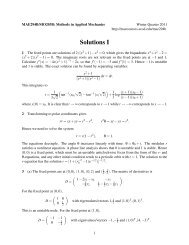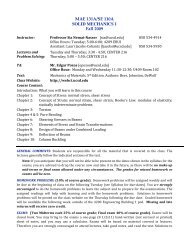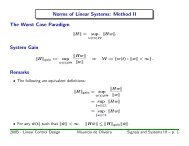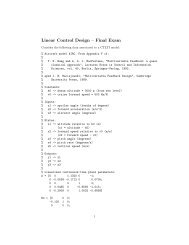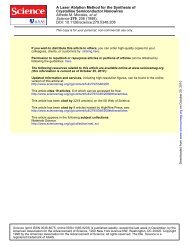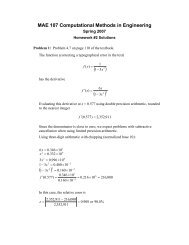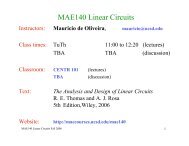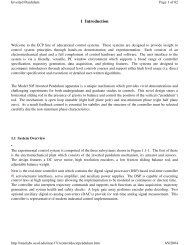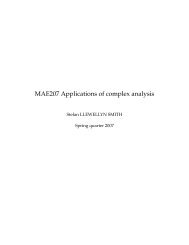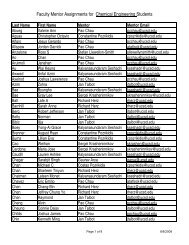Central Valley Aquifer, Chapters A and B - MAE Class Websites
Central Valley Aquifer, Chapters A and B - MAE Class Websites
Central Valley Aquifer, Chapters A and B - MAE Class Websites
You also want an ePaper? Increase the reach of your titles
YUMPU automatically turns print PDFs into web optimized ePapers that Google loves.
220 Groundwater Availability of the <strong>Central</strong> <strong>Valley</strong> <strong>Aquifer</strong>, California<br />
Example 1:<br />
= 30 inches<br />
1<br />
Head-dependent Combinations<br />
of Transpiration Components<br />
Case 1: Transpiration =<br />
Uptake from saturated root zone<br />
Case 2: Transpiration =<br />
Uptake from saturated root zone plus<br />
Capillary uptake from unsat. root zone<br />
Case 3: Transpiration =<br />
Uptake from saturated root zone plus<br />
Capillary uptake from unsat. root zone<br />
plus uptake from irrigation <strong>and</strong><br />
precipitation<br />
Case 4: Transpiration =<br />
Capillary uptake from unsat. root zone<br />
plus Uptake from irrigation <strong>and</strong><br />
precipitation<br />
Case 5: Transpiration =<br />
Uptake from irrigation <strong>and</strong><br />
precipitation<br />
T<br />
c-pot Potential Transpiration<br />
Tgw-sat Transpiration fed by groundwater<br />
uptake in saturated root zone<br />
Tgw-unsat Transpiration fed by capillary<br />
groundwater uptake in unsaturated<br />
root zone<br />
Ti Transpiration fed by irrigation<br />
Tp Transpiration fed by precipitation<br />
Ec-pot Potential Evaporation<br />
Egw-sat Surface Evaporation from<br />
ponding groundwater<br />
Egw-unsat Surface Evaporation fed by<br />
capillary rise from groundwater<br />
Ei Evaporation fed by irrigation<br />
Ep Evaporation fed by precipitation<br />
1<br />
EXPLANATION<br />
Positive pressure head with<br />
maximum transpiration<br />
2 Positive pressure head with<br />
zero transpiration<br />
Transpiration from fully active<br />
portion of the saturated<br />
rootzone (ASRZ1)<br />
Transpiration from partially<br />
active portion of the<br />
saturated rootzone (ASRZ2)<br />
Total Transpiration from the<br />
saturated root zone<br />
Ground<br />
Surface<br />
Root<br />
zone<br />
Capillary<br />
Fringe<br />
water<br />
level<br />
Tgw<br />
-Extinction<br />
1<br />
1<br />
water level<br />
2<br />
2<br />
water level<br />
Components of Transpiration <strong>and</strong><br />
Evaporation with varying Water Level<br />
T gw-unsat<br />
T c-pot<br />
E<br />
c-pot<br />
Capillary<br />
Fringe<br />
E -Extinction<br />
gw<br />
water<br />
level<br />
c-pot<br />
Tc-pot Tc-pot<br />
Flux<br />
Example 2:<br />
Root zone = 30 inches<br />
1<br />
2<br />
T gw-sat<br />
= 30 inches<br />
= 10 inches<br />
E gw<br />
T i T p E i<br />
Subcomponents of Transpiration<br />
from Saturated Conditions<br />
Root<br />
Zone<br />
E p<br />
Ground<br />
Surface<br />
1<br />
1<br />
1<br />
1<br />
2<br />
2<br />
2<br />
2<br />
water level<br />
water level<br />
Subcomponents of Transpiration<br />
from Saturated Conditions<br />
T<br />
Example 1:<br />
Root zone = 30 inches<br />
1<br />
2<br />
= 20 inches<br />
= 10 inches<br />
Flux<br />
Example 3:<br />
Root zone = 30 inches<br />
1<br />
2<br />
= 40 inches<br />
= 10 inches<br />
Flux<br />
Subcomponents of Transpiration<br />
from Saturated Conditions<br />
Figure 1-2. Conceptualization to the change of transpiration uptake from a saturated root zone with varying water level (Three<br />
examples with different 1 values; example 1 at top includes conceptualization of all transpiration <strong>and</strong> evaporation components with<br />
varying water level).<br />
Root<br />
Zone<br />
Root<br />
Zone



